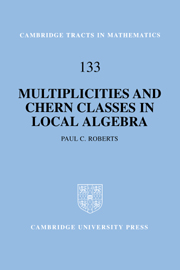Book contents
- Frontmatter
- Contents
- Preface
- Part One Multiplicities
- 1 Prime Ideals and the Chow Group
- 2 Graded Rings and Samuel Multiplicity
- 3 Complexes and Derived Functors
- 4 Homological Properties of Rings and Modules
- 5 Intersection Multiplicities
- 6 The Homological Conjectures
- 7 The Frobenius Map
- Part Two Chern Classes
- Bibliography
- Index
5 - Intersection Multiplicities
from Part One - Multiplicities
Published online by Cambridge University Press: 29 September 2009
- Frontmatter
- Contents
- Preface
- Part One Multiplicities
- 1 Prime Ideals and the Chow Group
- 2 Graded Rings and Samuel Multiplicity
- 3 Complexes and Derived Functors
- 4 Homological Properties of Rings and Modules
- 5 Intersection Multiplicities
- 6 The Homological Conjectures
- 7 The Frobenius Map
- Part Two Chern Classes
- Bibliography
- Index
Summary
In this chapter we discuss the definition of intersection multiplicities, a topic that we will take up again in the last chapter. The basic idea is to give a definition of the multiplicity of intersection of two subschemes of a scheme in such a way that it agrees with the intuitive notion of counting the number of intersections at a point and so that certain reasonable conditions will be satisfied. One condition is that the result should be independent of rational equivalence. A second is that the intersection of two smooth subschemes that meet transversally at a point should be one; algebraically, this condition states that if x1, … xd form a minimal set of generators of the maximal ideal of a regular local ring, and if the subschemes are defined by the ideals x1, … xk and xk+1, …xd, respectively, their intersection multiplicity should be one. Another condition, which we will discuss in a later chapter, is that Bézout's theorem must hold; that is, in projective space the total number of intersections of two subschemes should be the product of the degrees of the subschemes.
Another version of this problem is to attempt to define an intersection product on the Chow group to create a ring structure on the Chow group.
- Type
- Chapter
- Information
- Multiplicities and Chern Classes in Local Algebra , pp. 93 - 106Publisher: Cambridge University PressPrint publication year: 1998



